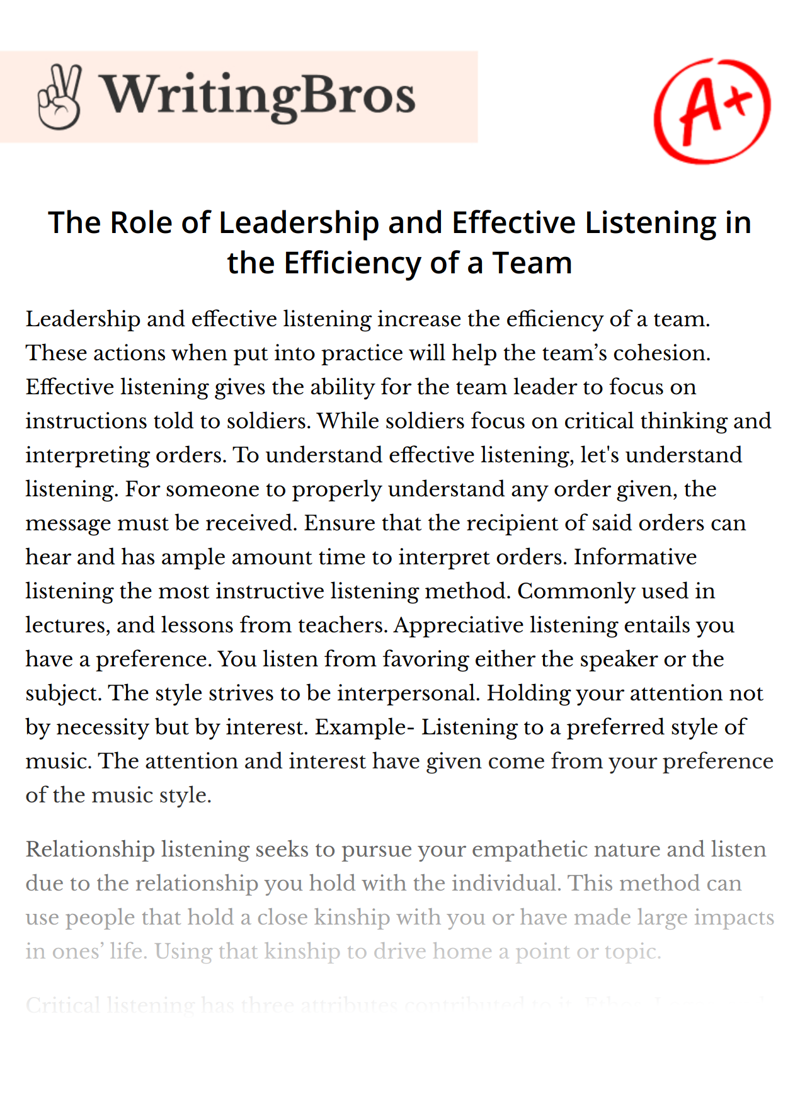The Role of Leadership and Effective Listening in the Efficiency of a Team

Leadership and effective listening increase the efficiency of a team. These actions when put into practice will help the team’s cohesion. Effective listening gives the ability for the team leader to focus on instructions told to soldiers. While soldiers focus on critical thinking and interpreting orders. To understand effective listening, let's understand listening. For someone to properly understand any order given, the message must be received. Ensure that the recipient of said orders can hear and has ample amount time to interpret orders. Informative listening the most instructive listening method. Commonly used in lectures, and lessons from teachers. Appreciative listening entails you have a preference. You listen from favoring either the speaker or the subject. The style strives to be interpersonal. Holding your attention not by necessity but by interest. Example- Listening to a preferred style of music. The attention and interest have given come from your preference of the music style.
Relationship listening seeks to pursue your empathetic nature and listen due to the relationship you hold with the individual. This method can use people that hold a close kinship with you or have made large impacts in ones’ life. Using that kinship to drive home a point or topic.
Critical listening has three attributes contributed to it, Ethos, Logos, and Pathos. Ethos represents the credibility of the speaker. The person may be a trustworthy individual or a common liar. Logos infers the data or logic of the statement whether the likelihood of the statement can be true. Pathos considers the psychological or emotional element behind the person’s claim. Capable critical thinking requires all three attributes to be sufficient critical listening.
Discriminative listening is the ability to differentiate the difference in pitch, volume, and emphasis. The listener can detect changes in these variables and determine the differences in meaning. Observing the responses and the impact associated with them an individual can increase their effectiveness in relationship listening. Knowing the individual and their social cues helps with picking on key emotional aspects of the conversation.
There are three factors attributed to this type of listening. Hearing ability is a factor due in part to whether you can allow an individual to state their claim or side without hindrance. These hindrances may change their tone and social speaking norms causing you to misread their emotional meaning. Awareness of Sound Structure, the practice of recognizing vowel and consonant sounds in a sentence structure. Then being able to infer the meaning behind the sounds without having received the sentence verbatim. For example- The stuff he knows or the stuffy nose, you won a Toyota, you won a toy Yoda, the good can decay many ways, the good candy came anyways.
Integration of nonverbal cues, the final factor for discriminative listening. This focuses on the physical characteristics of the speaker. Whether they are fidgeting, messing with their face or hands, or not making eye contact. These cues may show whether a person is giving information freely, under duress, or disorientation.
Now that we have a vague concept of effective listening let's delve into the mindset of the leader with this practice. An effective leader uses the practices earlier detailed to understand their subordinates and the obstacles they face. While the leader not using effective listening may overlook an issue that is impeding the completion of the mission. The task can be completed but the lack of attention given to the concerns of their subordinates may lead to mission failure.
Leaders use effective listening to absorb as much information from troops. Leaders use this information to better delegate and decide actions taken. Subordinates who practice effective listening benefit from the comprehension of orders given. This loop of comprehension ensures efficient task management.
Cite this Essay
To export a reference to this article please select a referencing style below

